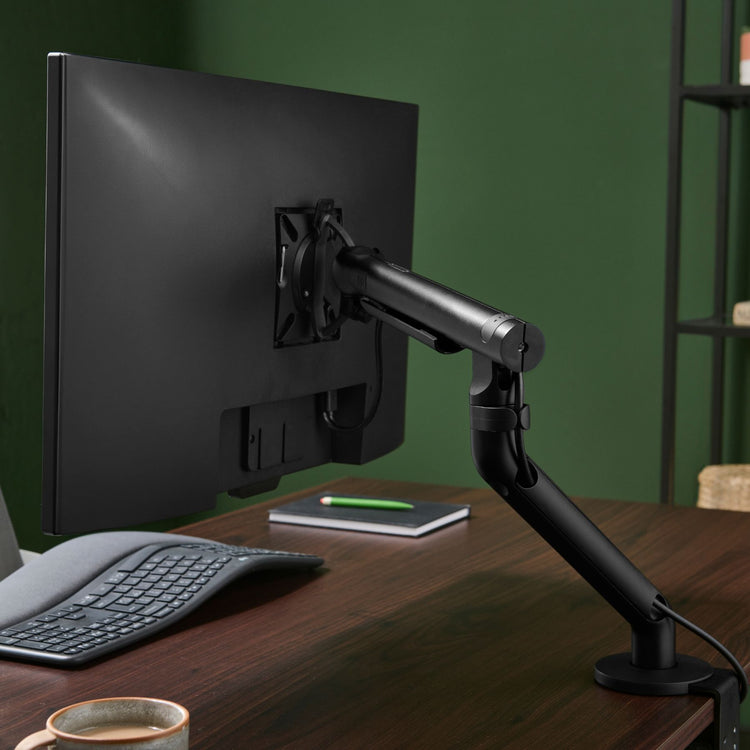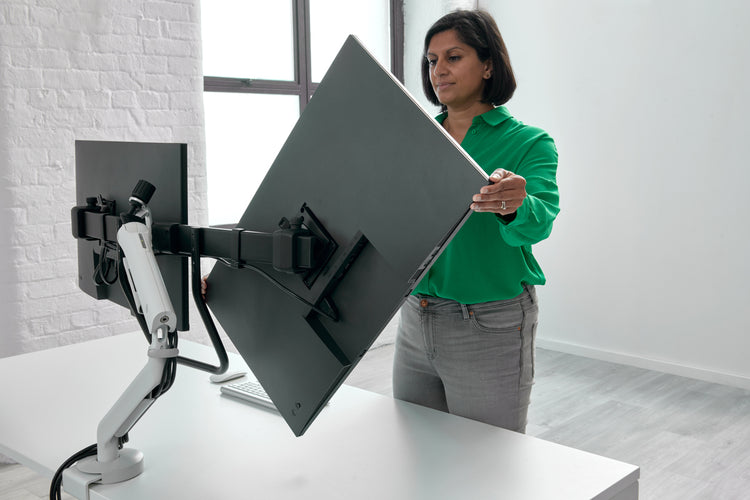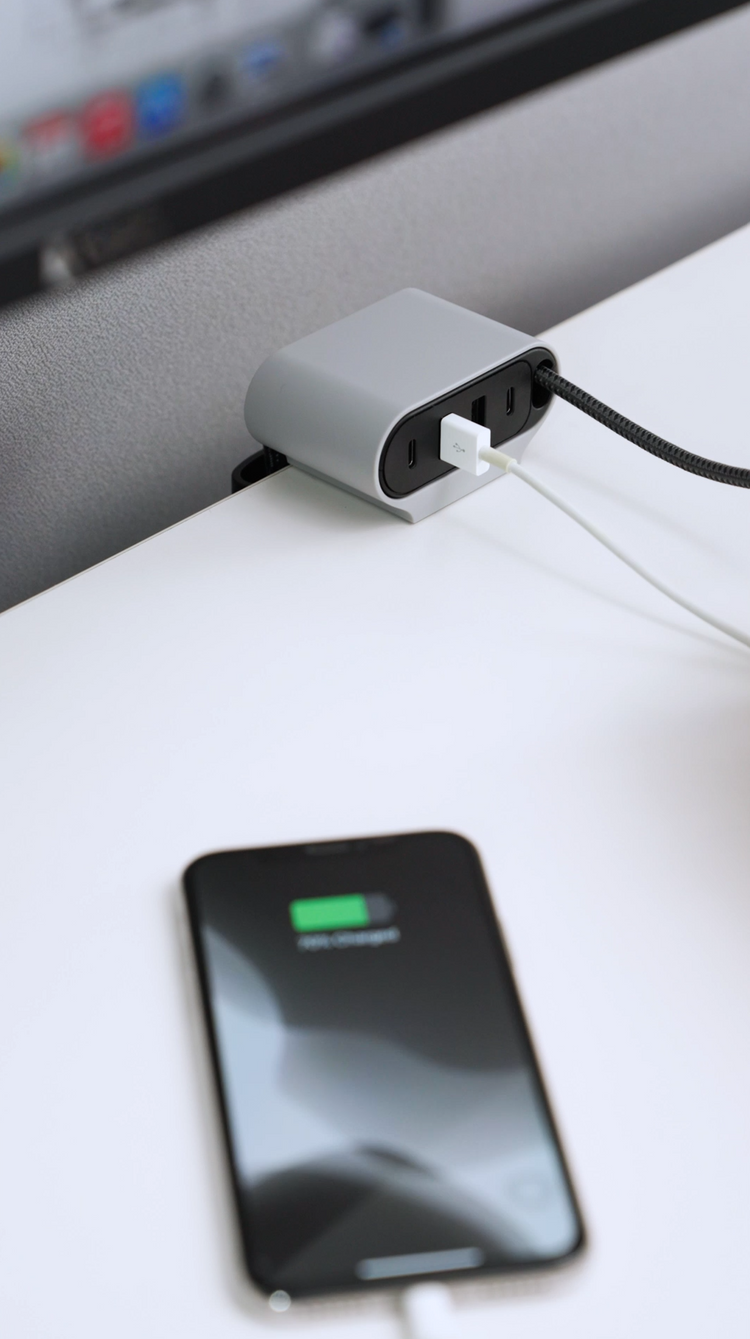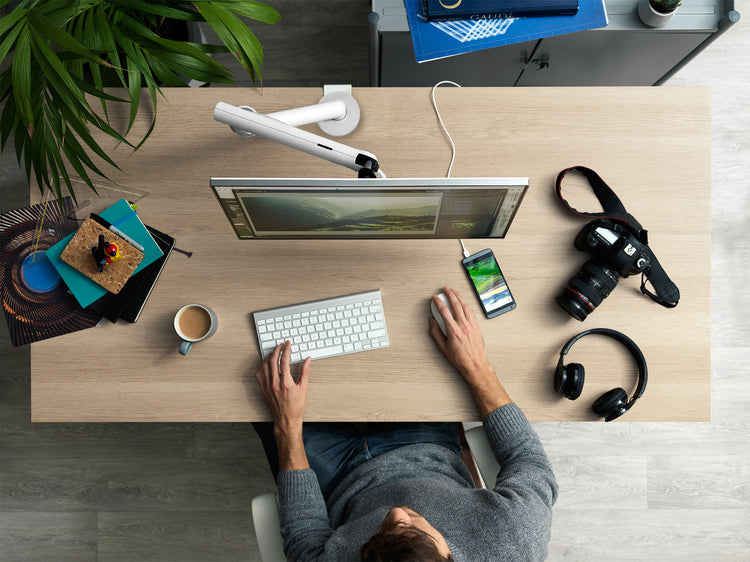An ergonomic workstation is important to maintain comfort and prevent strain or injury, especially if you’re working at your desk for long hours. Here is a step-by-step guide to designing an ergonomic workstation:
1. Monitor Position
- Monitor height: The top of your monitor screen should be at or just below your eye level. You should be able to look straight ahead at the monitor without tilting your neck up or down, as this can cause neck strain.
- Monitor distance: Adjust the monitor so you can read the screen without leaning forward or straining your eyes. Generally, an arm’s length away is a good estimate.
- Dual monitor setup: If you’re using two monitors, position the primary monitor directly in front of you and the secondary to the side. If you use both equally, place them together Generally, an arm’s length away is a good estimate.
A desk mount monitor arm is recommended to allow easy adjustment of your monitor. Alternatively if you only use a laptop, a laptop stand is recommended for ensuring your laptop is correctly positioned.
2. Chair Setup
- Adjustable Chair: Make sure you use an ergonomic chair that can support the natural curve of your spine. Your chair should be adjustable in height, backrest angle, lumbar support and armrest position.
- Seat height: Adjust the height so your feet are flat on the floor, with your thighs parallel to the ground. 90 degree rule is a good rule to follow, but ideally you want your hips to be ever so slightly higher than your knees.
- Backrest: Ensure your chair backrest supports your entire back, while promoting a natural (lumbar) curve. You want to have as much of your back in contact with the backrest, sitting slightly back of 90 degrees.
- Armrests: Adjust the armrests so your elbows are close to your body and form about a 90-degree angle, with your shoulders relaxed.
- Seat depth: Make sure you leave about 2-3 finger gap between the back of your knees and the front edge of the seat.
3. Keyboard and Mouse Position
- Keyboard: Keep your keyboard directly in front of you (place the B button in front of your belly button), with your forearms parallel to the floor or slightly angled downward (a negative tilt). Your wrists should remain straight and not rest on the desk while typing.
- Mouse: Place the mouse next to the keyboard at the same distance from the edge of the desk (roughly 10cm). You shouldn’t have to reach far to use it. Use your whole arm to move the mouse, not just your wrist joint.
An ergonomic keyboard that is split or angled and a vertical mouse can help maintain a more neutral wrist position.
4. Footrest
- If your fixed desk, and therefore chair, is too high for your feet to comfortably rest flat on the floor, use a footrest to support your feet and reduce pressure on your thighs.
5. Desk Height
Optimal height: Your desk should be at elbow height when you're sitting correctly, as detailed above. If you have a sit-stand desk, set yourself in the chair properly, and adjust the level to the elbow height.

6. Lighting
- Natural lighting: Make sure your desk is positioned to take advantage of natural light, but avoid glare by placing your monitor perpendicular to windows.
- Lamps: If working in low light/the evening, use lamps with adjustable brightness to avoid eye strain. Ensure any lamp lights don't reflect on the monitor.
7. Screen Glare and Eye Health
- Reduce glare: Position your monitor away from direct light sources or use anti-glare screens. Glare on monitor screens can cause eye strain, headaches, and fatigue.
- 20-20-20 rule: Every 20 minutes, look at something 20 feet away for at least 20 seconds to reduce eye strain.
8. Posture Tips
- Sitting posture: Make sure you sit upright (but slightly back of 90 degrees) with your back against the chair and shoulders relaxed. Keep your neck straight and avoid hunching forward.
- Standing desk: If using a standing desk, alternate between sitting and standing constantly throughout the day. 20mins sitting, 8mins standing, 2 minutes of walking around is the Golden Ratio according to Cornell University. When standing, keep your knees slightly bent and maintain the same ergonomic positioning for monitor and keyboard placement.
If you don’t have a standing desk, we recommend purchasing a Sit-Stand Riser which can convert your desk into a standing desk. This allows you to have full flexibility.

9. Organise Your Workspace
- Within reach: Keep frequently used items (like your phone, charger, or notepad) within easy reach to avoid overextending or twisting your body.
- Tidy Desk: Keeping a tidy desk can help reduce stress and improve focus.
10. Take Breaks
- Move around: When sitting for a long period of time, ensure that you stand up, stretch, or walk around every 30-60 minutes. Even small movements prevent stiffness and can improve your circulation.
- Stretching: Perform simple stretches for your neck, wrists, back, and legs throughout the day.
By following the steps above, you can create a more comfortable and healthy workspace that supports good posture, reduces strain, and helps maintain productivity.









